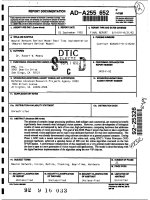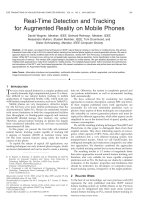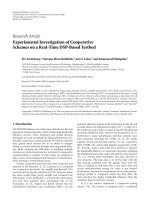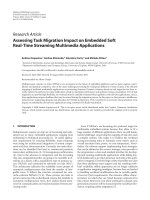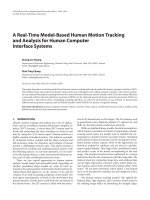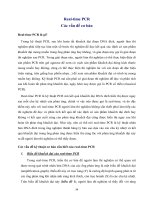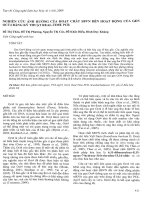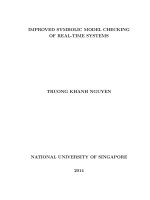AN1496 debugging stand alone real time clockcalendar based applications
Bạn đang xem bản rút gọn của tài liệu. Xem và tải ngay bản đầy đủ của tài liệu tại đây (215.2 KB, 8 trang )
AN1496
Debugging Stand-Alone Real-Time Clock/Calendar-Based Applications
Author:
Alexandru Valeanu
Microchip Technology Inc.
This application note describes how to debug an
application using Microchip’s MCP794XX and
MCP795XX RTCC devices.
Several code examples are detailed and explained in
Table 1.
INTRODUCTION
An increasing number of applications require Real-Time
Clock/Calendar (RTCC) devices.
Microchip’s RTCC’s (I2C™ and SPI) are feature-rich
devices that incorporate EEPROM, Time/Date
registers, Time-Stamp registers, alarm modules,
SRAM, a watchdog timer, and event detect modules,
making them useful in many timekeeping applications.
COMMON ISSUES
TABLE 1:
COMMON ISSUES
Problem
Solution
Take into account two main factors: hardware and firmware.
Hardware
The oscillator does not function
• Verify that you have the correct type and value of crystal. Every type of crystal
has specific parameters such as: CLOAD (equivalent capacitance of the
crystal); ESR (equivalent series resistor of the crystal, at the resonance
frequency).
• Verify that you have the correct values of the capacitors, as stated in the
crystal manufacturer’s data sheet and/or in Microchip’s documents.
• Make sure the board is clean. Some of the flux used in the Pb-free may be
slightly conductive; leaving residue on the board will delay the oscillator from
starting or prevent oscillation completely (a dirty board will create parasitic
resistors and capacitors).
• Verify your layout for the oscillator. An example is described in AN1365,
“Recommended Usage of Microchip Serial RTCC Devices”.
• Ensure that the crystal was not overheated during soldering.
Firmware
• Make sure the Start bit (ST) in register 00h is set; Set ST = 1 to enable the
oscillator.
• Check if the EXTOSC bit in the Control register (addr 07h) is clear; EXTOSC =
0. This should be cleared when using an external crystal.
The oscillator occasionally
starts and stops
The SRAM is losing data and
the clock is resetting when VCC
is removed
2013 Microchip Technology Inc.
If the oscillator starts and stops, it means that the Start bit is set. Take into account
only the hardware issues described above (crystal, capacitors, board, layout).
Additionally, moisture on the board can affect crystal operation, as can trying to
measure the crystal using a standard (x1 or x10) oscilloscope probe.
Make sure that you have enabled battery backup in the code, through the VBATEN
bit in register 03h; VBATEN = 1.
Measure the backup supply voltage to make sure it is within the specification given
in the data sheet.
DS01496A-page 1
AN1496
TABLE 1:
COMMON ISSUES (CONTINUED)
Problem
Cannot communicate with the
I2C™ device (or does not
acknowledge)
Solution
• Make sure that RTCC is powered and VCC > VTRIP.
• Verify the I2C bus is pulled high when inactive/idle..
• Ensure that you have the correct value pull-up resistors, refer to AN1028,
“Recommended Usage of Microchip I2C™ Serial EEPROM Devices”.
• Is the I2C bus address correct for the MCP794XX?
- Nonvolatile (EEPROM): 0xAE (for writes), 0xAF (for reads).
- Volatile (SRAM): 0xDE (for writes), 0xDF (for reads).
• Is the address of the byte location correct? Entering an address past 0x5F for
an SRAM operation will result in the MCP7941X not acknowledging the
address. Addressing undefined EEPROM locations will result in the
MCP7941X not acknowledging the address.
• Have you installed the battery? If your application does not need a battery, the
VBAT pin should be connected to ground.
Please consider two possible factors:
Hardware
MFP is an open-drain pin and needs a pull-up resistor. Verify that you have the
correct resistor and the pin is high at power-up.
Firmware
MFP may be used as clockout (in timekeeping applications) or as interrupt (in
alarm applications). The MFP pin can also be driven via the OUT bit. Ensure that
this bit is not being modified by the code.
MFP does not toggle
(MCP7941X)
In timekeeping applications (such as an electronic watch), MFP can output pulses
to offer a time reference.
An example of how to program the Control register (07h) for such an application is
described in the code of AN1355, “A Complete Electronic Watch Based on
MCP79410 I2C™ RTCC” (the code will toggle MFP at 1 Hz).
rtcc_wr(SQWE + ALM_NONE + MFP_1HZ, ADDR_CTRL), where constants
are defined as below:
#define
#define
#define
#define
ADDR_CTRL
SQWE
ALM_NONE
MFP_1HZ
0x07
0x40
0x00
0x00
//
//
//
//
address of the control register
MFP = square wave
no alarms activated
MFP = square wave at 1 Hz
In alarm applications, the initialization code could be (example from AN1364):
rtcc_wr(ALM_0, ADDR_CTRL)
;// enable ALARM0, OUT=0, no SQWAVE
rtcc_wr(ALMx_POL+ALMxC_ALL+MONDAY,
ADDR_ALM0CTL)
;// MFP=1 on ALARM, match on all
// (alarm) day of week for alarm = 1
vars,
Definitions of constants for this example are:
#define
#define
#define
#define
Alarms do not trigger
(MCP7941X)
DS01496A-page 2
ALM_0
ALMx_POL
ALMxC_ALL
ADDR_ALM0CTL
0x10
0x80
0x70
0x0d
//
//
//
//
ALARM0 is activated (ADDR_CTRL)
polarity of MFP alarm (ADDR_ALMxCTL)
ALARM compare on all param (ADDR_ALMxCTL)
address of ALARM0 CONTROL register
Same issues that may effect MFP apply:
• MFP is open-drain and needs a pull-up.
• The initialization code for an alarm application includes the two above
statements related to Control register (07h) and ALARM0 Control register
(0Dh).
2013 Microchip Technology Inc.
AN1496
TABLE 1:
COMMON ISSUES (CONTINUED)
Problem
Solution
An alarm cannot be retriggered
The alarm interrupt flag, ALMxIF (bit 3 in the Alarm Control registers), is set automatically by the hardware but must be cleared in firmware in order to retrigger the
alarm.
The previous examples of code show the correct procedure, too. After every alarm
match, re-initialize the alarm module, this is done by clearing the Alarm Interrupt
Flag (ALMxIF).
A read from an SPI device needs the master to produce the SPI clock. The clock
generator is started only when writing a byte in the SPI data buffer. Accordingly,
before reading the SPI device, write a byte in the SPI data buffer of the master. A
generic example of code for a PIC18 application (including the SPI RTCC) could
be:
Cannot read the SPI device
(MCP9752X)
Time is not accurate
unsigned char spi_rdbyte (void) { // READ A BYTE FROM THE SPI RTCC
unsigned char aux
; // auxiliary variable
SSP1BUF = 0x55
; // start ck generator, writing a dummy byte
// you may write any value in the range
00h - FFh
while (!PIR1bits.SSP1IF)
; // polling the SPI interrupt flag
aux=SSP1BUF
; // temporary variable to store the received
value
PIR1bits.SSP1IF = 0
; // clear the interrupt flag after end of
reception
return aux
; // return the SPI received value
This is the most common issue in timekeeping applications.
Inaccurate timekeeping can be caused by three factors: the 32,768 Hz crystal, the
two external capacitors and the thermal drift of the crystal. There are two methods
to solve the problem:
• A good choice/match of the two capacitors (which can solve the problem of
the offset of the frequency). Take into account the crystal tolerance.
• The calibration register of the RTCC, which can compensate the two
deviations of the frequency: offset and thermal drift.
The order of operations should be:
• Match the capacitors to the chosen crystal;
• Only after completing this, compensate the remaining offset through the
calibration register;
• The best tool to measure the frequency is an (expensive) high precision
counter/frequency-meter. Due to the low-power operation of the oscillator, this
cannot be tested with an oscilloscope probe without affecting the operation.
The 32.768 kHz clock can also be observed as a square wave by enabling the
CLKOUT.
• Tolerance of crystals.
• Crystal frequency varies with frequency. The system should be tested across
all temperature and environmental conditions.
• If the crystal is replaced with a device having equivalent parameters, the
system should be re-qualified.
Common Crystal Issues
Please refer to AN1365, “Recommended Usage of
Microchip Serial RTCC Devices” (DS01365).
2013 Microchip Technology Inc.
DS01496A-page 3
AN1496
CONCLUSION
A number of application notes are available to assist in
developing with the RTCC. These are available on the
Microchip web site at www.microchip.com/rtcc.
For additional information, please refer to the following
documents:
• AN1365 – “Recommended Usage of Microchip
Serial RTCC Devices”
• AN1364 – “Using the Alarm Feature on the
MCP79410 RTCC to Implement a Delayed Alarm”
• AN1355 – “A Complete Electronic Watch Based
on MCP79410 I2C™ RTCC”
• AN1413 – “Temperature Compensation of a
Tuning Fork Crystal Based on MCP79410”
• TB3065 – “Enabling Intelligent Automation Using
the MCP7941X I2C™ RTCC”
• AN1379 – “Stopwatch Based on MCP79410
I2C™ RTCC”
• AN1412 – “How to Calculate UNIX® Time Using a
PIC18 Microcontroller and the MCP795W20 SPI
RTCC”
DS01496A-page 4
2013 Microchip Technology Inc.
AN1496
APPENDIX A: REVISION HISTORY
Revision A (02/2013)
Initial Release.
2013 Microchip Technology Inc.
DS01496A-page 5
AN1496
NOTES:
DS01496A-page 6
2013 Microchip Technology Inc.
Note the following details of the code protection feature on Microchip devices:
•
Microchip products meet the specification contained in their particular Microchip Data Sheet.
•
Microchip believes that its family of products is one of the most secure families of its kind on the market today, when used in the
intended manner and under normal conditions.
•
There are dishonest and possibly illegal methods used to breach the code protection feature. All of these methods, to our
knowledge, require using the Microchip products in a manner outside the operating specifications contained in Microchip’s Data
Sheets. Most likely, the person doing so is engaged in theft of intellectual property.
•
Microchip is willing to work with the customer who is concerned about the integrity of their code.
•
Neither Microchip nor any other semiconductor manufacturer can guarantee the security of their code. Code protection does not
mean that we are guaranteeing the product as “unbreakable.”
Code protection is constantly evolving. We at Microchip are committed to continuously improving the code protection features of our
products. Attempts to break Microchip’s code protection feature may be a violation of the Digital Millennium Copyright Act. If such acts
allow unauthorized access to your software or other copyrighted work, you may have a right to sue for relief under that Act.
Information contained in this publication regarding device
applications and the like is provided only for your convenience
and may be superseded by updates. It is your responsibility to
ensure that your application meets with your specifications.
MICROCHIP MAKES NO REPRESENTATIONS OR
WARRANTIES OF ANY KIND WHETHER EXPRESS OR
IMPLIED, WRITTEN OR ORAL, STATUTORY OR
OTHERWISE, RELATED TO THE INFORMATION,
INCLUDING BUT NOT LIMITED TO ITS CONDITION,
QUALITY, PERFORMANCE, MERCHANTABILITY OR
FITNESS FOR PURPOSE. Microchip disclaims all liability
arising from this information and its use. Use of Microchip
devices in life support and/or safety applications is entirely at
the buyer’s risk, and the buyer agrees to defend, indemnify and
hold harmless Microchip from any and all damages, claims,
suits, or expenses resulting from such use. No licenses are
conveyed, implicitly or otherwise, under any Microchip
intellectual property rights.
Trademarks
The Microchip name and logo, the Microchip logo, dsPIC,
FlashFlex, KEELOQ, KEELOQ logo, MPLAB, PIC, PICmicro,
PICSTART, PIC32 logo, rfPIC, SST, SST Logo, SuperFlash
and UNI/O are registered trademarks of Microchip Technology
Incorporated in the U.S.A. and other countries.
FilterLab, Hampshire, HI-TECH C, Linear Active Thermistor,
MTP, SEEVAL and The Embedded Control Solutions
Company are registered trademarks of Microchip Technology
Incorporated in the U.S.A.
Silicon Storage Technology is a registered trademark of
Microchip Technology Inc. in other countries.
Analog-for-the-Digital Age, Application Maestro, BodyCom,
chipKIT, chipKIT logo, CodeGuard, dsPICDEM,
dsPICDEM.net, dsPICworks, dsSPEAK, ECAN,
ECONOMONITOR, FanSense, HI-TIDE, In-Circuit Serial
Programming, ICSP, Mindi, MiWi, MPASM, MPF, MPLAB
Certified logo, MPLIB, MPLINK, mTouch, Omniscient Code
Generation, PICC, PICC-18, PICDEM, PICDEM.net, PICkit,
PICtail, REAL ICE, rfLAB, Select Mode, SQI, Serial Quad I/O,
Total Endurance, TSHARC, UniWinDriver, WiperLock, ZENA
and Z-Scale are trademarks of Microchip Technology
Incorporated in the U.S.A. and other countries.
SQTP is a service mark of Microchip Technology Incorporated
in the U.S.A.
GestIC and ULPP are registered trademarks of Microchip
Technology Germany II GmbH & Co. KG, a subsidiary of
Microchip Technology Inc., in other countries.
All other trademarks mentioned herein are property of their
respective companies.
© 2013, Microchip Technology Incorporated, Printed in the
U.S.A., All Rights Reserved.
Printed on recycled paper.
ISBN: 9781620770252
QUALITY MANAGEMENT SYSTEM
CERTIFIED BY DNV
== ISO/TS 16949 ==
2013 Microchip Technology Inc.
Microchip received ISO/TS-16949:2009 certification for its worldwide
headquarters, design and wafer fabrication facilities in Chandler and
Tempe, Arizona; Gresham, Oregon and design centers in California
and India. The Company’s quality system processes and procedures
are for its PIC® MCUs and dsPIC® DSCs, KEELOQ® code hopping
devices, Serial EEPROMs, microperipherals, nonvolatile memory and
analog products. In addition, Microchip’s quality system for the design
and manufacture of development systems is ISO 9001:2000 certified.
DS01496A-page 7
Worldwide Sales and Service
AMERICAS
ASIA/PACIFIC
ASIA/PACIFIC
EUROPE
Corporate Office
2355 West Chandler Blvd.
Chandler, AZ 85224-6199
Tel: 480-792-7200
Fax: 480-792-7277
Technical Support:
/>support
Web Address:
www.microchip.com
Asia Pacific Office
Suites 3707-14, 37th Floor
Tower 6, The Gateway
Harbour City, Kowloon
Hong Kong
Tel: 852-2401-1200
Fax: 852-2401-3431
India - Bangalore
Tel: 91-80-3090-4444
Fax: 91-80-3090-4123
India - New Delhi
Tel: 91-11-4160-8631
Fax: 91-11-4160-8632
Austria - Wels
Tel: 43-7242-2244-39
Fax: 43-7242-2244-393
Denmark - Copenhagen
Tel: 45-4450-2828
Fax: 45-4485-2829
India - Pune
Tel: 91-20-2566-1512
Fax: 91-20-2566-1513
France - Paris
Tel: 33-1-69-53-63-20
Fax: 33-1-69-30-90-79
Japan - Osaka
Tel: 81-6-6152-7160
Fax: 81-6-6152-9310
Germany - Munich
Tel: 49-89-627-144-0
Fax: 49-89-627-144-44
Atlanta
Duluth, GA
Tel: 678-957-9614
Fax: 678-957-1455
Boston
Westborough, MA
Tel: 774-760-0087
Fax: 774-760-0088
Chicago
Itasca, IL
Tel: 630-285-0071
Fax: 630-285-0075
Cleveland
Independence, OH
Tel: 216-447-0464
Fax: 216-447-0643
Dallas
Addison, TX
Tel: 972-818-7423
Fax: 972-818-2924
Detroit
Farmington Hills, MI
Tel: 248-538-2250
Fax: 248-538-2260
Indianapolis
Noblesville, IN
Tel: 317-773-8323
Fax: 317-773-5453
Los Angeles
Mission Viejo, CA
Tel: 949-462-9523
Fax: 949-462-9608
Santa Clara
Santa Clara, CA
Tel: 408-961-6444
Fax: 408-961-6445
Toronto
Mississauga, Ontario,
Canada
Tel: 905-673-0699
Fax: 905-673-6509
Australia - Sydney
Tel: 61-2-9868-6733
Fax: 61-2-9868-6755
China - Beijing
Tel: 86-10-8569-7000
Fax: 86-10-8528-2104
China - Chengdu
Tel: 86-28-8665-5511
Fax: 86-28-8665-7889
China - Chongqing
Tel: 86-23-8980-9588
Fax: 86-23-8980-9500
Korea - Daegu
Tel: 82-53-744-4301
Fax: 82-53-744-4302
China - Hangzhou
Tel: 86-571-2819-3187
Fax: 86-571-2819-3189
Korea - Seoul
Tel: 82-2-554-7200
Fax: 82-2-558-5932 or
82-2-558-5934
China - Hong Kong SAR
Tel: 852-2943-5100
Fax: 852-2401-3431
Malaysia - Kuala Lumpur
Tel: 60-3-6201-9857
Fax: 60-3-6201-9859
China - Nanjing
Tel: 86-25-8473-2460
Fax: 86-25-8473-2470
Malaysia - Penang
Tel: 60-4-227-8870
Fax: 60-4-227-4068
China - Qingdao
Tel: 86-532-8502-7355
Fax: 86-532-8502-7205
Philippines - Manila
Tel: 63-2-634-9065
Fax: 63-2-634-9069
China - Shanghai
Tel: 86-21-5407-5533
Fax: 86-21-5407-5066
Singapore
Tel: 65-6334-8870
Fax: 65-6334-8850
China - Shenyang
Tel: 86-24-2334-2829
Fax: 86-24-2334-2393
Taiwan - Hsin Chu
Tel: 886-3-5778-366
Fax: 886-3-5770-955
China - Shenzhen
Tel: 86-755-8864-2200
Fax: 86-755-8203-1760
Taiwan - Kaohsiung
Tel: 886-7-213-7828
Fax: 886-7-330-9305
China - Wuhan
Tel: 86-27-5980-5300
Fax: 86-27-5980-5118
Taiwan - Taipei
Tel: 886-2-2508-8600
Fax: 886-2-2508-0102
China - Xian
Tel: 86-29-8833-7252
Fax: 86-29-8833-7256
Thailand - Bangkok
Tel: 66-2-694-1351
Fax: 66-2-694-1350
Italy - Milan
Tel: 39-0331-742611
Fax: 39-0331-466781
Netherlands - Drunen
Tel: 31-416-690399
Fax: 31-416-690340
Spain - Madrid
Tel: 34-91-708-08-90
Fax: 34-91-708-08-91
UK - Wokingham
Tel: 44-118-921-5869
Fax: 44-118-921-5820
China - Xiamen
Tel: 86-592-2388138
Fax: 86-592-2388130
China - Zhuhai
Tel: 86-756-3210040
Fax: 86-756-3210049
DS01496A-page 8
Japan - Tokyo
Tel: 81-3-6880- 3770
Fax: 81-3-6880-3771
11/29/12
2013 Microchip Technology Inc.
